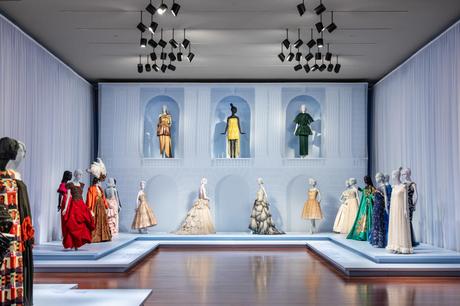The selling - and wearing - of French fashion shaped San Francisco's cosmopolitan identity until the early 20th century, so much so that the first French dresses imported after World War II, including a Jacques Costet velvet and silk Little Black Dress from 1946 that was on display. was sold by I. Magnin, was front page news in the San Francisco Chronicle.
The story continues
Department stores in the Bay Area, most notably I. Magnin, signed agreements to copy French couture and sell it to the society. The museum's costume collection particularly benefited from the patronage of Grover Magnin (I. Magnin was founded by his parents) and his wife Jeanne, a former model and close friend of Christian Dior. Their donations include the beautiful Venus and Junon dresses from Dior's 1949 fall couture collection, which toured the West Coast as part of the store's traveling fashion exhibitions. With their petal-shaped skirts and glittering sequins, they would look right at home on the 2024 red carpet.

In many cases, local donors had close relationships with designers, not only supporting them by purchasing their clothes, but also financing runway collections and businesses. Georgette "Dodie" Rosekrans financed John Galliano's early collections, and his spring 1999 Dior couture suit, designed to be worn backwards, is one of her many avant-garde looks on display.
On display are two promised gifts from Hale, including a dress by Irish designer Sybil Connolly, which the philanthropist and Best Dressed Hall of Famer wore when Queen Elizabeth came to the museum for a state dinner.
And Tatiana Sorokko, a model and muse of Ralph Rucci, is represented by her Fall 2007 digitally printed couture baby dress worn to the San Francisco Symphony Opening Night Gala. Another major donor, Christine Suppes, showcased several looks from Alexander McQueen, Vivienne Westwood and Rodarte, which she has supported.
"There are a lot of women here who are not only interested in fashion as wearing clothes, but also in supporting the industry," says Camerlengo.
While many of the city's fashion enthusiasts were white and born or married into wealth, the exhibition aims to show how that's changing by including two looks by Christopher John Rogers, donated by black tastemaker Sherri McMullen, who built the designer from the beginning to her support. Oakland store. Also included is a dramatic gold-embroidered green dress with puff sleeves by Edwin Oudshoorn, worn to a ballet gala by Silicon Valley director Tanum Davis Bohen.
However, one wishes that space was devoted to fleshing out the biographies of all these women, perhaps with more photos of them wearing the designs of Chanel, Bill Blass, Yohji Yamamoto and more.
Camerlengo continually considers the Pacific Rim's enduring influence on European and American designer inspiration (and appropriation) and on local immigration. The work of two prominent Chinese-American designers from San Francisco is spotlighted: Kaisik Wong, who emerged from the art-to-wear movement in the 1970s and is best known for a patchwork vest copied by Nicolas Ghesquière at Balenciaga, and the more traditional seamstress Richard Tam.
"Richard Tam emerged in the 1960s and 1970s as a top designer in the US who made clothing for women here, as well as Ethel Kennedy and Dinah Shore," says the curator. 'He worked as a couture designer and I have seen things on the market attributed to Balenciaga that were a Tam design, dating from the 1960s.
"It's a great opportunity to celebrate their work," she said of Wong and Tam. "Both designers died very young, and their stories have been somewhat lost in traditional history and narratives, as well as being of great significance to our communities who still remember them. I would love to have a major exhibition of Tam's work, which is housed at the Met, the museum at FIT and other major museums, but has never been extensively studied."
These are the ancestors of other Asian-American designers, including Derek Lam and Alexander Wang, both from the Bay Area.
Camerlengo isn't out to define San Francisco style, she said. "There are people who buy the best of French fashion and import it into the city, and there are women who make their own clothes, and women who can't work with crowds and use newspapers to fill a skirt, and people who wear traditional cultural clothing. clothing," she said of the range. "That's representative of how San Francisco still dresses today. What you see in the timeline are people like Sherri McMullen and Tanum Davis Bohen, self-made women, and how they connect in different ways to the long thread of women emerging in the San Francisco public sphere."
Another woman of our times would be Anna Chiu, co-founder of San Francisco fashion brand Kamperett, who recently dressed Awkwafina, Abby Elliott and Diane Lane for awards season events, and whose sheer silk organza volume dresses and blouses with thoughtful details such as qipao - inspired tie closures, architectural sleeves and intricate seams are beloved by style makers in the Bay Area and beyond.
"It's inspiring. the level of complexity and imagining the people who wore these," Chiu said as he viewed the collection Wednesday morning.
It would be interesting to continue the exhibition's dialogue with contemporary Bay Area labels, she agreed, including sustainable labels that are creating solutions to today's natural disasters, and perhaps San Francisco-born Levi's, which has done more than any mark anyway. democratize fashion.
For now, seeking visitors can take advantage of the museum's partnership with tech company Snapchat for a virtual tasting experience featuring three AR mirrors with exhibition looks from Dior, Valentino and Wong.
As Thomas P. Campbell, director and chief executive of the Fine Arts Museums of San Francisco, said, "If we want to make museums open and friendly, fashion can be important... and with all this fragile clothing that can't be touched, it seemed it's a great opportunity."
The best of WWD